China Takes Over P5 Process, Repeats No-First-Use Call with African States
Nuclear Disarmament Monitor
September 12, 2024
Nuclear Disarmament Monitor
September 12, 2024
ACA Research Assistant Shizuka Kuramitsu speaks at the UNGA high-level plenary for the International Day Against Nuclear Tests (IDANT).
Closing the Door on Nuclear Testing to Honor Past Generations and Build a Better Future for the Next Generations
Shizuka Kuramitsu, Research Assistant, Arms Control Association, and former participant of the #Leaders4Tomorrow project of the UN Office for Disarmament Affairs’ #Youth4Disarmament Programme
President of the General Assembly,
Excellencies,
Ladies and Gentlemen,
At the outset, allow me to thank His Excellency Dennis Francis, President of the General Assembly, and the UN Office for Disarmament Affairs for this opportunity. Thank you for your leadership in keeping the world’s attention on this priority issue as we commemorate the International Day Against Nuclear Testing of last week.
My name is Shizuka Kuramitsu - I am a former participant of the #Leaders4Tomorrow project of the UN Office for Disarmament Affairs’ #Youth4Disarmament Programme, who now working as a research assistant at a civil society organization called the Arms Control Association in Washington D.C.
As a representative of civil society and member of an emerging, younger generation of nuclear disarmament researchers and activists, I would like to share the following observations for Member States to consider.
Our generation is very concerned. We see growing dangers of nuclear weapons and feel aghast at the human consequences of past nuclear weapons development, testing, and use.
I am a native of Hiroshima, where the first nuclear test explosion in warfare took place. I grew up surrounded by the A-bomb survivors in my hometown. I heard their testimonials from generations of hibakusha about the horrors of the first use of nuclear weapons in war.
As if the bombings of the people of Hiroshima and Nagasaki were not horrific and inhumane enough, the world's nuclear weapons states have detonated more than 2,000 nuclear weapon test explosions.
The adverse health, social, environmental, and enduring consequences of these detonations is still too poorly understood, and the victims and survivors are still in need of medical monitoring and assistance. Their voices need to be heard and answered.
We need more research, more resources, and more support for nuclear testing victims.
We need acknowledgement and apologies for the wrongs committed in the past.
We need to see a strong commitment to never repeat the evil of nuclear detonations.
About ten years ago, former UN Secretary-General Ban Ki-Moon said:
“The best way to honour the victims of past tests is to prevent any in the future.”
I agree.
But we must continually ask ourselves: Are we doing what is necessary to prevent further detonations for nuclear weapon testing or any nuclear detonations in a war in the future?
No, we are not.
Collectively, we are not doing enough to strengthen the taboo against the use and testing of nuclear weapons, not doing enough to halt a new arms race, and not doing enough to get back on track to build a world without nuclear weapons.
We must recall that generations of concerned citizens, scientists, diplomats, doctors, mothers and fathers from around the world pressed global leaders to ban nuclear testing in the atmosphere, then everywhere through the 1996 CTBT.
Even though the treaty has not yet entered into force, it remains one of the most successful nuclear risk reduction and nonproliferation agreements in history.
But we cannot take it for granted.
Just in the past months, a former national security official called for a resumption of U.S. nuclear testing, and another state withdrew its ratification of the CTBT.
As we observe another International Day Against Nuclear Testing, we must honor communities around the world that have been harmed by nuclear testing, and past generations who have fought for a global test moratorium.
We need more than statements, we need actions. Now is the time to do so by recommitting ourselves to prevent the resumption of nuclear testing through energetic, high-level, bilateral, and multilateral diplomacy through all possible channels, the UN General Assembly, the Security Council and beyond.
Going forward, we can rebuild relationships, break the trust deficit, stop the what-aboutism, and act in the interest of humanity.
As my generation knows, when we start telling ourselves that we're doing enough, we stop moving forward and improving as a person.
When we point fingers at one another, even young people know that we will fail to halt the arms race.
Failure must never be an option - particularly for my generation, who will inherit this world and live with its consequences.
On behalf of a concerned, younger generation, I call on all UN Member States, especially those that have conducted nuclear detonations in the past, to be accountable, and commit to all possible efforts to preserve the taboo against nuclear testing so my generation -- and the generations that follow -- can live in a world without the fear of nuclear explosions and in a world that is moving closer to the elimination of all nuclear weapons.
Thank you for your attention.
September 2024 Digital Magazine
Avoiding Nuclear War Through Nuclear Failsafe
September 2024
By Steven Andreasen
At a time of heightened global tensions, when a handful of leaders with only a few minutes of decision time could determine the world’s fate, the next U.S. president must prioritize nuclear risk reduction. Faster, more powerful delivery systems and new technologies, including cyber and artificial intelligence, are increasing the risk of nuclear blunders.1 The best way to reduce these risks is global nuclear failsafe.2
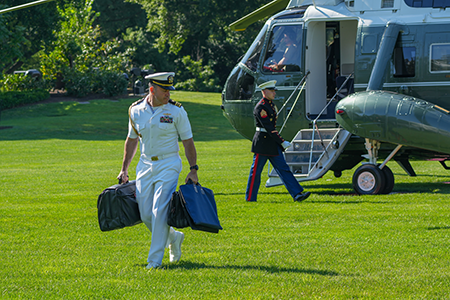
“Failsafe” refers to safeguards that prevent the unauthorized, accidental, or mistaken use of a nuclear weapon. In the United States, these safeguards could involve nuclear policy or force posture, such as adopting a no-first-use policy or modifying the nuclear triad. They also could include procedures that would strengthen the decision-making process for nuclear use, such as placing guardrails around the president’s sole authority to authorize the use of nuclear weapons. Further, they could involve the design of nuclear weapons or delivery systems, for example, by ensuring that they are built to prevent a terrorist from using a stolen bomb or by installing a system that would allow for the postlaunch destruction of nuclear weapons or their associated delivery systems if launched by mistake.
Hollywood has highlighted these risks through iconic performances by its biggest stars. In the 1964 movie “Failsafe,” Moscow is destroyed by a U.S. nuclear bomber due to computer error. The box-office hit “Dr. Strangelove” involves an unauthorized U.S. nuclear attack on Russia instigated by the mad commander of U.S. nuclear forces. In the 1990s, “Crimson Tide” depicted a tense standoff between a U.S. nuclear submarine captain and his executive officer over whether a U.S. nuclear strike on Russia has been properly authorized.
The epilogue to “Crimson Tide” notes that Washington was taking steps to ensure that the scenario in the movie could not happen. Those steps were mandated in an independent review by the Kirkpatrick Commission, which the George H.W. Bush administration initiated at the urging of Senator Sam Nunn (D-Ga.).3 In 1992 the commission authorized more than 50 steps to prevent unauthorized, accidental, or mistaken nuclear use, but that was more than 30 years ago during the digital Stone Age. Since then, the world has entered a new era, with new threats and new technologies.
The good news: In the 2022 National Defense Authorization Act, Congress mandated a new independent failsafe review.4 The Biden administration included a commitment to conduct this review in its Nuclear Posture Review with the results due this fall.5
The responsibility will fall to the next U.S. president to ensure that the review’s recommendations are implemented, to think creatively about enacting additional steps that might be needed and to institutionalize a process of future failsafe reviews to keep pace with evolving threats. Finally, the next president should make a major push to internationalize failsafe reviews in every nuclear-armed state. These reviews can be done without any agreements, treaties, or verification.
Each nation with nuclear arms has a responsibility to reduce the risk of nuclear blunders and can benefit from unilateral actions and similar actions taken by other nuclear powers. Leaders must give themselves every available tool to prevent a mistake from turning into a catastrophe.
ENDNOTES
1. Ernest J. Moniz and Sam Nunn, “The Return of Doomsday,” Foreign Affairs, Vol. 98, No. 5, (September/October 2019), https://www.foreignaffairs.com/articles/russian-federation/2019-08-06/return-doomsday.
2. Euro-Atlantic Security Leadership Group, “Advancing Global Nuclear ‘Fail-Safe,’”
February 2023, https://www.nti.org/wp-content/uploads/2023/02/EASLG-Statement_GNFS_FINAL-022723.pdf.
3. U.S. Department of Defense, “Final Report of the Federal Advisory Committee on Nuclear Risk Reduction (FARR),” n.d., https://archive.org/details/FinalReportoftheFederalAdvisory
CommitteeonNuclearFailsafeandRiskReductionFARR/mode/2up.
4. The 2022 National Defense Authorization Act states, “The Secretary of Defense shall provide for the conduct of an independent review of the safety, security, and reliability of covered nuclear systems. The Secretary shall ensure that such review is conducted in a manner similar to the review conducted by the Federal Advisory Committee on Nuclear Failsafe and Risk Reduction.” National Defense Authorization Act for Fiscal Year 2022, Pub. L. No. 117-81, 135 Stat. 1541 (2021).
5. The 2022 Nuclear Posture Review states, “[A]s directed by the National Defense Authorization Act for Fiscal Year 2022, [the Department of Defense] will commission an independent review of the safety, security, and reliability of U.S. nuclear weapons, [nuclear command, control, and communications], and integrated tactical warning/attack assessment systems.” U.S. Department of Defense, “2022 Nuclear Posture Review,” October 27, 2022, p. 13, https://media.defense.gov/2022/Oct/27/2003103845/-1/-1/1/2022-NATIONAL-DEFENSE-STRATEGY-NPR-MDR.PDF#page=49.
Steven Andreasen, the National Security Council’s staff director for defense policy and arms control from 1993 to 2001, teaches national security policy and crisis management at the Hubert H. Humphrey School of Public Affairs at the University of Minnesota.
How to Spend $1 Trillion for the Military?
September 2024
By Jessica Sleight
The next U.S. president will inherit a program to modernize each leg of the U.S. nuclear triad (intercontinental ballistic missiles (ICBMs), submarines, and bombers) to the tune of $1.7 trillion. The program is already marred by delays and overruns, including an 81 percent increase in the cost of the Sentinel ICBM and doubts over the ability of the National Nuclear Security Administration (NNSA) to meet plutonium pit production goals. Additionally, China’s nuclear expansion and Russia’s growing reliance on nuclear coercion have fueled calls for an expanded U.S. nuclear force in the name of deterring two nuclear peer adversaries.
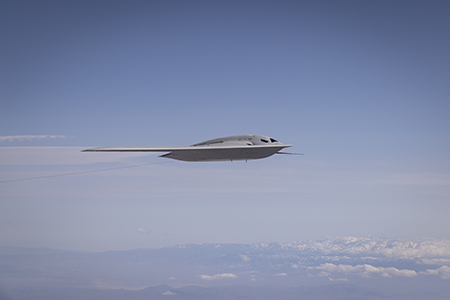
The next president will need to prioritize a rethinking of nuclear strategy that avoids fear-based, short-term thinking; guards against gatekeeping and steamrolling by the military-industrial complex; and takes a holistic approach to strategic deterrence. The decisions made over the next four years will shape the U.S. nuclear arsenal for decades to come.
For former President Donald Trump, the influence of the Heritage Foundation, crafters of Project 2025, cannot be overlooked. A new report by a Heritage expert calls for the nuclear modernization program to be “accelerated and expanded,” including a new road-mobile ICBM, additional nuclear-armed submarines, and new nuclear variants of hypersonic, anti-ship, and intermediate-range missiles.1 It also calls for a small, accelerated nuclear strategy development process; the NNSA to be put on “wartime footing”; and forgoing some safety and environmental regulations in order to move quickly.
There is little justification for such steps, aside from an ambiguous “deterrence gap,” and no real consideration of budgetary impacts. Nevertheless, a second Trump administration likely would have little hesitancy with implementation, having previously introduced new capabilities, including a low-yield warhead for sea-based nuclear missiles. Following up with recommendations from the Heritage report would increase the bloated nuclear budget, threaten to replicate past harms to communities and the environment, further isolate nuclear decision-making, and place the United States squarely in a new nuclear arms race.
As a U.S. senator, Vice President Kamala Harris opposed the development of new low-yield nuclear warheads and encouraged broad interagency input into nuclear strategy development.2 As vice president, Harris has not had much presence on these issues, indicating that her potential administration may follow the Biden administration’s lead.
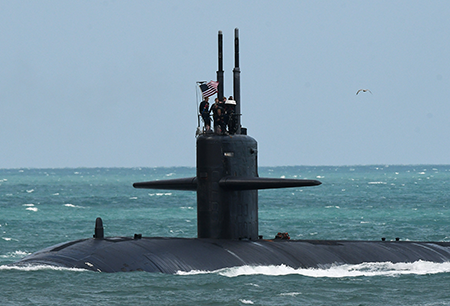
Recently, Biden officials announced a new strategic review and consideration of options to increase deployed nuclear weapons and other adjustments to U.S. posture to address the new threat environment.3 This comes on the heels of the 2023 report produced by the bipartisan Congressional Commission on the Strategic Posture of the United States, which deemed the current modernization program “necessary but not sufficient.”4 Although the new strategic review is necessary, such efforts traditionally fall victim to momentum, tinkering at the margins of strategy development, undervaluing discussion of risks associated with U.S. action, and shutting down perspectives that may threaten current or future programs. It will be important for a potential Harris administration to stand against such practices.
The difference between a modernization program that ensures a credible nuclear deterrent and one that needlessly throws resources at new and additional weapons starts with nuclear strategy. There are additional options for a future administration to consider. For example, taking adversarial forces off the nuclear targeting list could alleviate a so-called need for new nuclear capabilities and decrease incentives for preemptive nuclear use.
It is imperative that the next president demand in-depth analysis of all options and refrain from deferring to those that conflate supremacy with security. Sober analysis of the assumptions, risks, budget implications, impacts on local communities and the environment, and non-nuclear strategic deterrence tools can save the United States from entering an unwinnable arms race.
ENDNOTES
1. Robert Peters, “A Nuclear Posture Review for the Next Administration,” Heritage Foundation Special Report, No. 287 (July 30, 2024), https://www.heritage.org/sites/default/files/2024-07/SR287.pdf.
2. See Edward J. Markey et al., Letter to Rex W. Tillerson, James N. Mattis, and Rick Perry, July 19, 2017, https://www.markey.senate.gov/imo/media/doc/2017-07-19-Markey-letter-State-Energy-DoD-NuclearPostureReview.pdf; “Harris Statement on Vote Against NDAA,” VoteSmart, June 18, 2018, https://justfacts.votesmart.org/public-statement/1257967/harris-statement-on-vote-against-ndaa/.
3. “Nuclear Threats and the Role of Allies: A Conversation With Acting Assistant Secretary Vipin Narang,” Center for Strategic and International Studies, n.d., https://csis-website-prod.s3.amazonaws.com/s3fs-public/2024-08/240801_Narang_Conversation_Secretary.pdf?VersionId=ITu9zdugiGiBfBig7gUEICXnw9nYn9yR (transcript of August 1, 2024, event).
4. Congressional Commission on the Strategic Posture of the United States, “America’s Strategic Posture,” October 2023, https://www.ida.org/-/media/feature/publications/a/am/americas-strategic-posture/strategic-posture-commission-report.ashx.
Jessica Sleight is the Janne E. Nolan Nuclear Security Fellow at the Truman Center for National Policy.
Preventing a Resumption of Nuclear Testing
September 2024
By Lynn Rusten
For 32 years, under Republican and Democratic administrations, the United States has observed a moratorium on explosive nuclear weapons testing. U.S. leadership prompted other countries to cease
testing and to complete negotiation of the Comprehensive Test Ban Treaty (CTBT) in 1996.
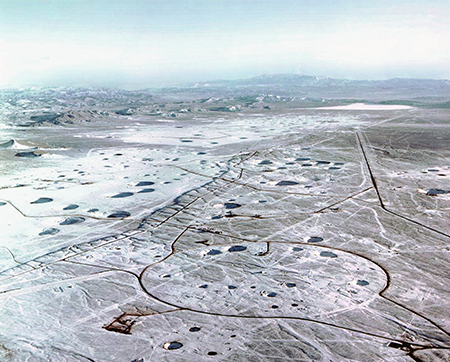
Today, the national security, environmental, and humanitarian benefits of what has become a global moratorium are indisputable. The five states recognized as nuclear-weapon states under the nuclear Nonproliferation Treaty (NPT) have been observing a moratorium on nuclear testing since 1996 (1990 for the Soviet Union/Russia, 1991 for the United Kingdom, 1992 for the United States, and 1996 for China and France).
Of the world’s nine nuclear-armed states, only North Korea has tested since 1998. Between 1945 and the mid-1990s, there were approximately 2,000 explosive nuclear tests worldwide, with more than 500 tests conducted aboveground or underwater. The devasting environmental and health consequences of these tests for private citizens and veterans persist to this day, including in the United States.1
For these and other reasons, a resumption of nuclear testing would face widespread opposition in the United States and globally. Yet, some, including the former national security adviser to President Donald Trump, are suggesting that the United States do just that.2
Fortunately, there is an alternative. The United States relies on the Stockpile Stewardship Program (SSP), which uses science-based assessments of nuclear weapons to ensure confidence in the safety, reliability, and effectiveness of its nuclear stockpile without the need for explosive nuclear testing. This program has proven remarkably successful.3 Every U.S. president since Bill Clinton has determined through the SSP that resuming explosive nuclear testing is scientifically and technically unnecessary, based on the assessment and certification by the directors of the national weapons laboratories.
A return to testing for any other reason, such as to develop new nuclear weapons or create negotiating leverage with Russia or China, would be extremely shortsighted. If the United States were to resume testing, a cascade of other states—Russia, perhaps China, and more—likely would follow suit, and proliferation pressures could grow on states that currently do not have nuclear weapons but might seek them.
The United States has the most to lose from a multilateral resumption of nuclear testing because of the high confidence in its stockpile provided by the SSP without testing. Other states may think they have more to gain by developing and testing new weapon types, but this too would be shortsighted.
A return to testing, particularly by any of the five NPT nuclear-weapon states, also risks unraveling the global nuclear nonproliferation regime. The commitment to conclude a test ban treaty was central to achieving the indefinite extension of the NPT in 1995. A return to nuclear testing would seriously erode the credibility of the nuclear-weapon states’ commitment to the NPT and their obligation to work toward nuclear disarmament. It also would exacerbate mounting frustrations among the non-nuclear-weapon states.
The next president should recognize the national security benefits of upholding the U.S. moratorium on explosive nuclear testing and encouraging all nuclear-armed states to maintain their moratoriums on nuclear testing. Beyond that, the president should advance the longer-term goal of U.S. ratification of the CTBT and work with other states to bring the treaty into force. The alternative, a resumption of nuclear testing in their backyards and beyond, will never be welcomed by the American people or the international community.
ENDNOTES
1. “Downwinders and the Radioactive West,” PBS, October 3, 2022, https://www.pbs.org/video/downwinders-and-the-radioactive-west-usugap/; Morgan Knibbe, “The Atomic Soldiers,” The New York Times, February 12, 2019.
2. Robert C. O’Brien, “The Return of Peace Through Strength: Making the Case for Trump’s Foreign Policy,” Foreign Affairs, Vol. 103, No. 4 (July/August 2024), https://www.foreignaffairs.com/united-states/return-peace-strength-trump-obrien.
3. “Managing an Arsenal Without Nuclear Testing: An Interview With Jill Hruby of the U.S. National Nuclear Security Administration,” Arms Control Today, Vol. 53, No. 10 (December 2023): 14-18.
Lynn Rusten is vice president for the Global Nuclear Policy Program at the Nuclear Threat Initiative.
Russia and Its Nuclear Modernization Plans
September 2024
By Amy J. Nelson
How the candidates should handle Russia and its nuclear modernization program centers on two important questions: What should U.S. nuclear policy be in light of sovereign states that break from the status quo, particularly with respect to the nuclear order? How can the United States best prepare for nuclear eventualities resulting from Russia’s modernization plan, given that Russia no longer is constrained by the Intermediate-Range Nuclear Forces (INF) Treaty and perhaps even the New Strategic Arms Reduction Treaty (New START)?

Russia’s aggressive actions over the past decade signal a departure from the major powers’ norms of behavior, which historically have included good-faith participation in international institutions and promotion of a rules-based order. Russia’s revisionist and risk-seeking tendencies include incursions into sovereign states, exerting undue influence over its neighbors, and claiming territory in states that flank NATO. Its behavior tracks an equally troubling course for nuclear norms. In the mid-2010s, Russia violated the INF Treaty, which banned all ground-launched ballistic and cruise missiles with ranges between 500 and 5,500 kilometers, with its 9M729 missile. Russia denied the violation and refused to provide transparency into the nuclear weapons system or to modify it in any way. The United States eventually withdrew from the treaty because of Russian noncompliance.1
In 2022, Russia suspended U.S. inspections under New START after the West imposed sanctions in response to Russia’s full-scale invasion of Ukraine.2 In February 2023, Russia escalated its noncompliance by suspending participation in New START more broadly, halting inspections and data sharing. It stated, however, that it would still respect the treaty’s limits. The United States responded by halting its own obligations under the treaty, including ceasing to share certain data on missile launches and to participate in inspections.3
Additionally, Russia has been accused of providing nuclear assistance and technologies to Iran and North Korea and blocking or weakening nuclear nonproliferation language in UN Security Council resolutions. Russia also has occupied the Zaporizhzhia Nuclear Power Plant in Ukraine, using the facility as a nuclear shield, violating norms concerning the protection of civilian infrastructure in wartime and increasing the risk of a nuclear accident.4
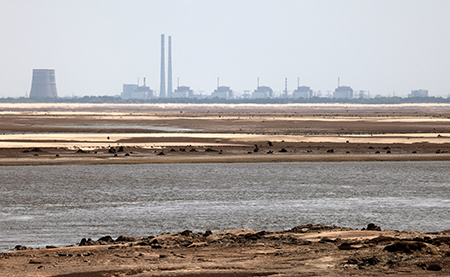
Russia’s most risky violation of nuclear norms may be its threatened nuclear use. This has included statements that Russia might use nuclear weapons if its own security is threatened and signals that it might be willing to escalate its war in Ukraine from a conventional conflict to a nuclear one.5 The United States has condemned such rhetoric.6
Meanwhile, Russia continues its military modernization plans, including for its nuclear forces. Although aimed at optimizing conventional forces for quick campaigns and decisive outcomes, these plans also involve the development of novel strategic weapons, including nuclear-powered cruise missiles, nuclear-powered “torpedoes,” and a hypersonic boost-glide system. These destabilizing systems are designed to evade U.S. missile defenses and complicate traditional deterrence calculations.7
Such developments highlight shortcomings with and challenges for U.S. nuclear policy. Russia’s saber-rattling underscores the paradox of possessing nuclear weapons for deterrence purposes, which requires signaling to an adversary a willingness to use them, but then balking at threats associated with their use. Because disarmament is not feasible in the near term, the United States must work with the four other main nuclear-weapon states to redefine the obligation of responsible nuclear powers to uphold deterrence norms.
Further, Russia is pursuing its exotic nuclear systems with no formal Comprehensive Test Ban Treaty (CTBT) in place, only an informal moratorium that is weakening. Russia signed the treaty in 1996, ratified it in 2000, then withdrew ratification in 2023. The United States signed the treaty in 1996 but never ratified. Ratifying the CTBT could prove an important tool in constraining Russia’s development of novel nuclear weapons.
ENDNOTES
1. Shannon Bugos, “U.S. Completes INF Treaty Withdrawal,” Arms Control Today, September 2019, https://www.armscontrol.org/act/2019-09/news/us-completes-inf-treaty-withdrawal.
2. Shannon Bugos, “Russia Further Pauses New START Inspections,” Arms Control Today, September 2022, https://www.armscontrol.org/act/2022-09/news/russia-further-pauses-new-start-inspections.
3. Bureau of Arms Control, Deterrence, and Stability, U.S. Department of State, “U.S. Countermeasures in Response to Russia’s Violations of the New START Treaty,” June 1, 2023, https://www.state.gov/u-s
-countermeasures-in-response-to-russias-violations-of-the-new-start-treaty/.
4. Amy J. Nelson and Chinon Norteman, “What to Do About the Zaporizhzhia Nuclear Power Plant,” Brookings: Order From Chaos blog, March 23, 2023, https://www.brookings.edu/articles/what-to-do-about-the-zaporizhzhia-nuclear-power-plant/.
5. Jim Sciutto, “Exclusive: U.S. Prepared ‘Rigorously’ for Potential Russian Nuclear Strike in Ukraine in Late 2022, Officials Say,” CNN, March 9, 2024, https://www.cnn.com/2024/03/09/politics/us-prepared-rigorously-potential-russian-nuclear-strike-ukraine/index.html.
6. “Remarks by National Security Advisor Jake Sullivan for the Arms Control Association (ACA) Annual Forum,” The White House, June 2, 2023, https://www.whitehouse.gov/briefing-room/speeches-remarks/2023/06/02/remarks-by-national-security-advisor-jake-sullivan-for-the-arms-control-association-aca-annual-forum/.
7. Matthew Kroenig, Mark Massa, and Christian Trotti, “Russia’s Exotic Nuclear Weapons and Implications for the United States and NATO,” Atlantic Council Issue Brief, March 2020, https://www.atlanticcouncil.org/wp-content/uploads/2020/07/Russias-Exotic-Nuclear-Weapons.pdf.
Amy J. Nelson is a visiting fellow in the International Security Program at New America and an adjunct faculty at Georgetown University.
Dealing With a China That Will Not Talk
September 2024
By James M. Acton
If states behaved like rational adults, China and the United States would sit down and try to negotiate an agreement to head off their emerging nuclear arms race. Unfortunately, that is not going to happen.
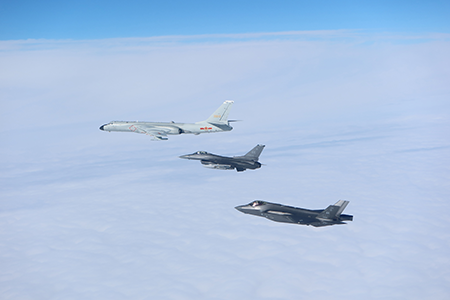
Beijing has made it very clear that it has “no interest” in discussing arms limitations.1 If it changed its mind, it would become immediately apparent how little thought the United States has put into the question of what it would be prepared to give China in return for such limits. Although the next U.S. administration should think through this issue and articulate a vision for a mutually beneficial Chinese-U.S. arms control regime, even talks appear unlikely for the foreseeable future.
Fueled by a growing bipartisan consensus that the United States must augment its nuclear force in response to China’s nuclear buildup and the possibility that Beijing may forge some kind of alliance with Moscow, a Chinese-U.S. arms race now seems virtually certain.2 Indeed, the last legal barrier to this outcome, the limits on long-range nuclear forces imposed by the New Strategic Arms Reduction Treaty (New START), will expire just more than one year into the next president’s term.
Yet, even if averting a new arms race will be extremely difficult, the next president still should try to do that by forcing the bureaucracy to consider its costs seriously. Specifically, the next president should require, as part of the next nuclear posture review, a realistic assessment of the feasibility of effective nuclear “counterforce” operations, the U.S. practice of targeting an opponent’s nuclear forces and command-and-control systems, compared to the alternatives.3
As far as is publicly known, although the Pentagon draws up plans to limit damage to the extent possible, it does not assess whether those plans would meet a presidentially determined threshold for effectiveness. Furthermore, the president should make clear that the alternatives to counterforce targeting should not involve aiming nuclear weapons at civilians. Instead, the United States could exclusively target conventional military forces and war-supporting industry, which have been on the U.S. target list for decades.4
Counterforce targeting is justified primarily as a way to enable the United States to limit the damage it would suffer in a nuclear war. It provides the intellectual ballast for why the United States should build up its nuclear arsenal in response to China; the more nuclear weapons Beijing has, the more Washington needs to destroy them preemptively. Thus, the congressionally mandated 2024 strategic posture commission calls on the Pentagon to modify its nuclear posture to “address the larger number of targets.”5
As part of the next nuclear posture review, the president should require the intelligence community and the Department of State to analyze how China and, for that matter, Russia would respond to a U.S. buildup. Would Beijing simply pursue its existing plans. or would it further augment its force requirements? After all, an arms race, which would be expensive and raise tensions, would be worth running only if it actually ended up increasing the security of the United States.
If China can ensure that U.S. counterforce attacks would not limit meaningfully the damage that the United States would suffer in a nuclear war, arms racing would be an exercise in pure futility. The next president should want to know what kind of arms race the country will be running before the spending bill that begins it is placed on the Resolute Desk.
ENDNOTES
1. Ministry of Foreign Affairs of the People’s Republic of China, “Department of Arms Control and Disarmament Holds Briefing for International Arms Control and Disarmament Issues,” July 8, 2020, https://web.archive.org/web/20211014015131/https:/www.fmprc.gov.cn/mfa_eng/wjbxw/t1795979.shtml.
2. Congressional Commission on the Strategic Posture of the United States, “America’s Strategic Posture,” October 2023, https://www.ida.org/-/media/feature/publications/a/am/americas-strategic-posture/strategic-posture-commission-report.ashx.
3. Charles L. Glaser, James M. Acton, and Steve Fetter, “The U.S. Nuclear Arsenal Can Deter Both China and Russia: Why America Doesn’t Need More Missiles,” Foreign Affairs, October 5, 2023, https://www.foreignaffairs.com/united-states/us-nuclear-arsenal-can-deter-both-china-and-russia.
4. James Acton, “Two Myths About Counterforce,” War on the Rocks, November 6, 2023, https://warontherocks.com/2023/11/two-myths-about-counterforce/.
5. Congressional Commission on the Strategic Posture of the United States, “America’s Strategic Posture,” p. viii.
James M. Acton is the Jessica T. Mathews Chair and co-director of the Nuclear Policy Program at the Carnegie Endowment for International Peace.
Gaza Tensions Complicate Iranian Nuclear Threat
September 2024
By Barbara Slavin
The next president’s ability to handle the simmering issue of Iran’s advancing nuclear program will be complicated by Tehran’s growing regional influence and the spiraling Gaza war, which was triggered by Hamas’ heinous October 7 attack on Israel and since has embroiled Iran and other Iran-backed militant groups in various ways.
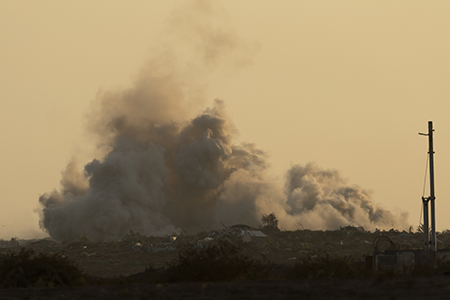
Former President Donald Trump, who withdrew the United States in 2018 from the nuclear deal with Iran known as the Joint Comprehensive Plan of Action (JCPOA), has long insisted that he could negotiate a better deal. Like presidents before and after him, he also has said that he would never allow Iran to develop nuclear weapons and has advocated a policy of “maximum pressure.”1 Informed of an alleged Iranian plot to kill him in retaliation for his order to assassinate Iran’s most important general, Qassem Soleimani, in 2020, Trump threatened “to wipe [Iran] off the face of the earth” if Tehran succeeded.2
Vice President Kamala Harris has not laid out views on Iran that differ significantly from the Biden administration approach. She has demonstrated more empathy than President Joe Biden for the Palestinians, however, and spoken of the intensifying Israeli-Hamas conflict as not a “binary” matter, suggesting a nuanced understanding of the region and support for diplomacy.3 In this, she has been helped by her national security adviser, Philip Gordon, who nearly two decades ago criticized the George W. Bush administration for “benign neglect” toward European-led nuclear talks with Iran and wrote a book opposing the Bush policy of forceful regime change in the Middle East.4
Despite the plethora of other crises likely to face the next president, deescalating tensions with Iran should remain a priority. The best approach would be ending the Gaza war in a durable manner. As long as that war continues, the danger of a wider conflagration remains, eroding any hope of reaching new understandings with Iran on any topic.
If relative peace could be established, the next administration should embrace a step-by-step approach that diminishes Iran’s incentive to move from threshold nuclear status to nuclear- weapon-possessor state. As others have suggested, there should be a series of reciprocal concessions by the United States on sanctions and by Iran on transparency and monitoring.5
Iran just inaugurated a new president, who has stressed the need for sanctions relief to boost the country’s battered economy. He has assembled a team of advisers that includes key figures who negotiated the JCPOA. To stabilize the Iran file before leaving office, the lame-duck Biden administration should resume contacts with Iran via Oman and Iran’s UN mission in New York.
If Harris wins, the United States will be well positioned to continue such work. If Trump is elected, the prospects for diplomacy with Tehran are less certain but not impossible. As one former Trump adviser said recently, “As long as you call it the ‘Trump Plan of Action and not JCPOA 2.0,’ and tell Trump he could win a Nobel prize, diplomacy with Iran can proceed.”6
ENDNOTES
1. “Remarks by President Donald Trump on Iran,” January 8, 2020, https://trumpwhitehouse.archives.gov/briefings-statements/remarks-president-trump-iran/.
2. “Trump: ‘If Iran Assassinates Me, U.S. Must Wipe It Off the Face of the Earth,’” Agence France-Presse, July 26, 2024.
3. “Remarks by Vice President Harris Following Meeting With Prime Minister Benjamin Netanyahu of Israel,” The White House, July 25, 2024, https://www.whitehouse.gov/briefing-room/speeches-remarks/2024/07/25/remarks-by-vice-president-harris-following-meeting-with-prime-minister-benjamin-netanyahu-of-israel/.
4. Barbara Slavin, Bitter Friends, Bosom Enemies: Iran, the U.S. and the Twisted Path to Confrontation (New York: St. Martin’s Press, 2007), p. 212; Philip H. Gordon, Losing the Long Game: The False Promise of Regime Change in the Middle East (New York: St. Martin’s Press, 2020).
5. Kelsey Davenport, “Constraining Iran’s Nuclear Potential in the Absence of the JCPOA,” Arms Control Association Policy White Paper, July 2024, https://www.armscontrol.org/sites/default/files/files/PolicyPapers/ACA_PolicyPaper_Iran_2024.pdf.
6. Confidential comment to the author at a recent Track 1.5 meeting with Iranians.
Barbara Slavin is a distinguished fellow at the Stimson Center and editor of Middle East Perspectives.
Grappling With North Korea’s Expanding Arsenal
September 2024
By Jean H. Lee
Former President Donald Trump has claimed that he and Kim Jong Un “fell in love” and speculated that the North Korean leader misses him.1 Vice President Kamala Harris has said she can promise one thing: she will not be exchanging love letters with Kim.2
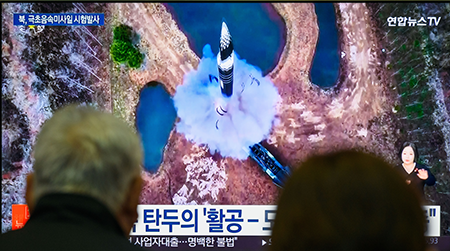
Whoever occupies the White House in 2025, North Korea’s nuclear program will be exponentially more challenging. Over the past decade, Kim has been amassing the arsenal of his dreams, one that is bigger and more dangerous than ever, including solid-fueled ballistic missiles, hypersonic weapons, and submarine-launched ballistic missiles.3
The problem extends beyond the Korean peninsula. North Korea allegedly is providing Russia with ammunition and ballistic missiles for the war in Ukraine,4 as well as Hamas with rockets for the conflict in Gaza,5 thus underlining the urgency of addressing a threat with global implications.
Now is the time for the U.S. presidential nominees to develop careful strategies on how to do that. These policies must anticipate Kim’s actions. They need to be tough yet creative, and the candidates need to be pragmatic.
Going into the presidency with no plan would cede the advantage to North Korea, which already is working to intensify tensions by provoking South Korea and the United States.6 The tensions are part of a bid to draw attention to North Korea in the leadup to the U.S. election, influencing its outcome and flagging North Korea as a foreign policy priority for the next administration.
Yet, Kim will not make it easy even if Trump becomes president. Any sustainable nuclear deal with North Korea will be more difficult than ever to negotiate. Not only is Pyongyang’s arsenal bigger, but the sanctions regime is weakened, and the stakes are even higher, for Kim and for the world.
The burgeoning relationship between Russia and North Korea also makes diplomacy more difficult. Russian President Vladimir Putin’s state visit to Pyongyang in June yielded a military pact that gives North Korea the potential to acquire specialized technology that could enable further nuclear advancement under the guise of space exploration. A Russian veto at the UN Security Council has deprived the international community of a way to track North Korean sanctions violations.7
Meanwhile, Kim has worked to blunt the impact of sanctions and isolation by investing in cybertheft. North Korean hackers are accused of stealing more than $3 billion through cyberattacks in recent years.8 The North Koreans know they need a contingency plan to accommodate geopolitical shifts, including the possibility that Trump may lose. They are watching closely for opportunities, especially as they make tentative steps out of isolation. But that window might be brief.
Harris, if elected, should be swifter in introducing a revamped North Korea policy than President Joe Biden was in 2020. She should explore creative ways to provide North Korea with a face-saving way to return to nuclear negotiations. That means remaining aggressive against cybertheft while stepping up collaboration with allies, as well as China and maybe Russia, on shared proliferation concerns.9
The candidates need to show strength in the face of the North Korean threat, but they also need to display diplomatic dexterity in seizing the opportunity that a change of administration can offer. The alternative of four more years of unfettered North Korean nuclear development must be considered untenable.
ENDNOTES
1. Former President Donald Trump, speech at Republican National Convention, July 2024.
2. Council on Foreign Relations, “Candidates Answer CFR’s Questions,” n.d., https://www.cfr.org/election2020/candidates-answer-cfrs-questions.
3. See Arms Control Association, “Arms Control and Proliferation Profile,” June 2024, https://www.armscontrol.org/factsheets/arms-control-and-proliferation-profile-north-korea.
4. U.S. Defense Intelligence Agency, “North Korea: Enabling Russian Missile Strikes Against Ukraine,” May 2024, https://www.dia.mil/Portals/110/Documents/News/Military_Power_Publications/DPRK_Russia_NK_Enabling_Russian_Missile_Strikes_Against_Ukraine.pdf.
5. Kim Soo-yeon, “S. Korea’s Spy Agency Confirms Hamas’ Suspected Use of N. Korean Weapons,” Yonhap News Agency, January 8, 2024.
6. Mike Valerio, Yoonjung Seo, and Brad Lendon, “North Korea Claims It’s Sending 250 New Missile Launchers Toward the South Korean Border,” CNN, August 5, 2024, https://www.cnn.com/2024/08/04/asia/north-korea-new-missile-launchers-border-intl-hnk.
7. George Lopez, “With Russia’s U.N. Veto, Where Do North Korea Sanctions Go From Here?” U.S. Institute of Peace, June 30, 2024, https://www.usip.org/publications/2024/07/russias-un-veto-where-do-north-korea-sanctions-go-here.
8. Edith M. Lederer, “UN Experts Investigating 58 Suspected North Korean Cyberattacks Valued at About $3 Billion,” February 9, 2024, https://apnews.com/article/un-experts-north-korea-cyberattacks-nuclear-sanctions-8e84703049dfb4fda011829115777c9e.
9. U.S. Cybersecurity and Infrastructure Security Agency, “North Korea Cyber Threat Overview and Advisories,” n.d., https://www.cisa.gov/topics/cyber-threats-and-advisories/advanced-persistent-threats/north-korea (accessed August 11, 2024).
Jean H. Lee, a journalist who opened the AP news bureau in Pyongyang and reported from North Korea for nine years, co-hosts the Lazarus Heist podcast about North Korea for the BBC World Service.